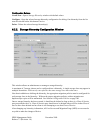the administrator to reflect desired behavior.
If files have been stored in a storage class without a migration policy, and a migration policy is
subsequently configured for it, the files created before the addition of the policy will not be migrated.
Use the mkmprec utility to create migration records for these files so that they will migrate properly. See
the mkmprec man page for more information.
When a migration or purge policy is modified, or when a storage class configuration is modified to use a
different migration policy, the affected Migration Purge Servers and Core Servers must be restarted in
order for the new policy to take effect.
Optimum Access Size, Device I/O Rate (DIOR), and Average Latency are used only in an advisory
capacity by HPSS unless a site has written a special interface using the Client API that takes advantage
of the COS Hints capability and uses these fields in doing so. Generally, they can be changed at will, but
should be set to accurately reflect their intended usage.
Maximum VVs To Write can be changed as desired. Changes made to this field will not take effect
until the Core Server(s) providing service to the storage class are re-started.
Max Multiplier (MAXMULT), Min Multiplier (MINMULT), and Average Number of Storage
Segments can be changed as desired for disk storage classes.
To change the Storage Segment Size fields Media Type, Stripe Width (SW), or Blocks Between
Tape Marks (BBTM), the existing storage class definition must be deleted and recreated with the new
desired values. Take care to either remove migration and purge policies that are no longer needed or
reassign them to the revised storage class. Because a number of servers cache storage class definitions, it
is best to make these changes when only SSM is running. Care should be taken in making these changes.
See the HPSS Installation Guide, Section 3.10: Storage Characteristics Considerations.
6.1.6. Deleting a Storage Class Definition
Before deleting a storage class definition, be sure that all of the subsystem-specific warning and critical
thresholds are set to “default”. If this is not done, one or more threshold records will remain in metadata
and will become orphaned when the storage class definition is deleted.
To delete a storage class definition, ensure that no files exist in this storage class and it is no longer
referenced in any hierarchy. All of the virtual volumes in this storage class should also be deleted, using
the Delete Resources or Reclaim operation. Once the storage class is empty and it is not referenced from
any hierarchy definition, the storage class definition can be removed.
See Section 8.7: New Storage Technology Insertion on page 291 for related information.
See also the dump_acct_sum utility, which can quickly verify the number of files in each COS.
It is recommended HPSS Customer Support be called for assistance with this operation.
6.2. Storage Hierarchies
This section describes how to create, modify, and delete storage hierarchies.
6.2.1. Hierarchies Window
An HPSS storage hierarchy can be created and managed using the Hierarchies window. This window is
HPSS Management Guide November 2009
Release 7.3 (Revision 1.0) 170


















